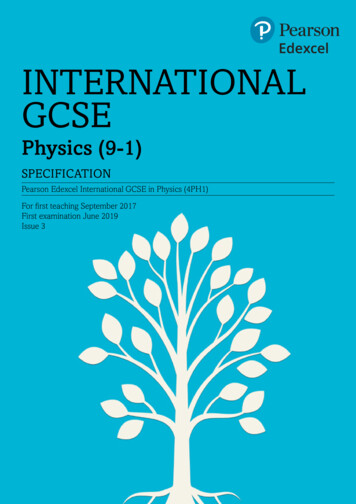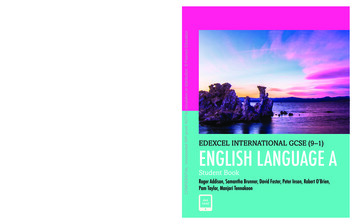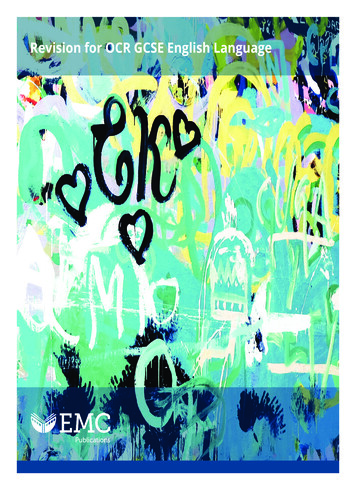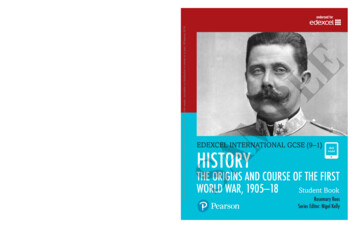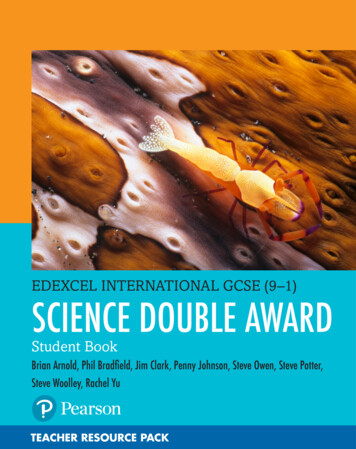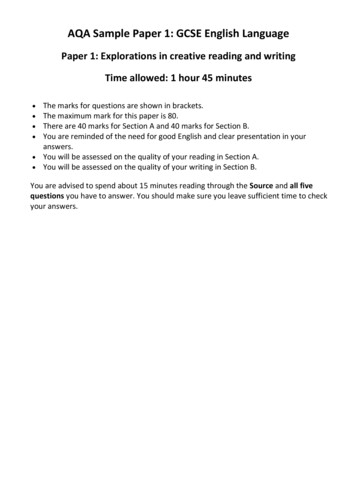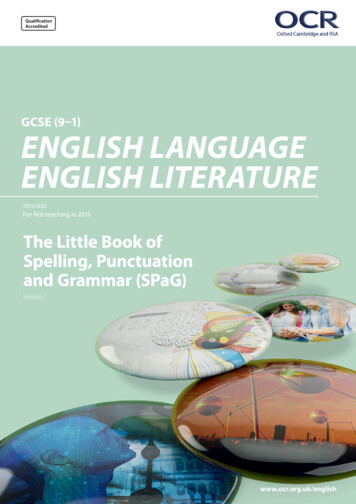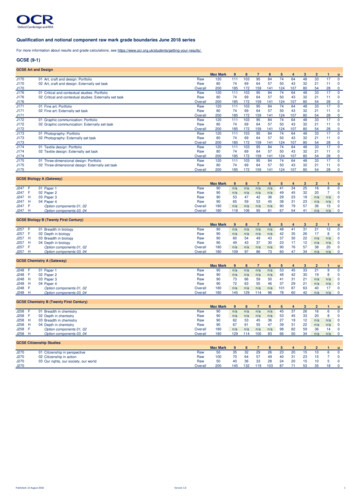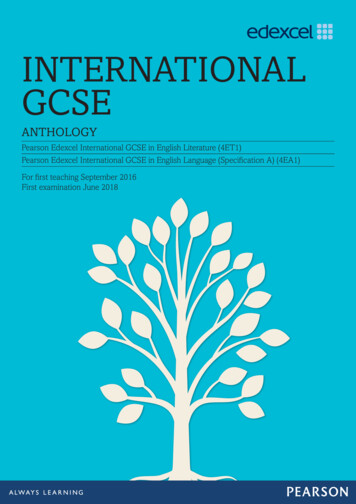
Transcription
INTERNATIONALGCSEANTHOLOGYPearson Edexcel International GCSE in English Literature (4ET1)Pearson Edexcel International GCSE in English Language (Specification A) (4EA1)For first teaching September 2016First examination June 2018
INTERNATIONAL GCSEEnglish AnthologyANTHOLOGYPearson Edexcel International GCSE English Anthology for use with:Edexcel International GCSE in English Literature (4ET1)Edexcel International GCSE in English Language (Specification A) (4EA1)Edexcel International GCSE in English Language (Specification B) (4EB1)
Published by Pearson Education Limited, 80 Strand, London, WC2R 0RL.Copies of official specifications for all Edexcel qualifications may be found on the website:qualifications.pearson.com Pearson Education Limited 2016First published 201619 18 17 1610 9 8 7 6 5 4 3 2 1British Library Cataloguing in Publication DataA catalogue record for this book is available from the British Library.ISBN 978 1 446 93108 0Copyright noticeAll rights reserved. No part of this publication may be reproduced in any form or by anymeans (including photocopying or storing it in any medium by electronic means and whetheror not transiently or incidentally to some other use of this publication) without the writtenpermission of the copyright owner, except in accordance with the provisions of theCopyright, Designs and Patents Act 1988 or under the terms of a licence issued by theCopyright Licensing Agency, Saffron House, 6–10 Kirby Street, London EC1N 8TS(www.cla.co.uk). Applications for the copyright owner’s written permission should beaddressed to the publisher.
ContentsInternational GCSE English Language (Specification A)Part 1: Paper 1 Section A Non-fiction textsFrom The Danger of a Single Story, Chimamanda Ngozi Adichie2From A Passage to Africa, George Alagiah4From The Explorer’s Daughter, Kari Herbert6Explorers or boys messing about? Either way, taxpayer gets rescue bill, Steven Morris 8From Between a Rock and a Hard Place, Aron Ralston10Young and dyslexic? You’ve got it going on, Benjamin Zephaniah12From A Game of Polo with a Headless Goat, Emma Levine14From Beyond the Sky and the Earth: A Journey into Bhutan, Jamie Zeppa17From H is for Hawk, Helen Macdonald20From Chinese Cinderella, Adeline Yen Mah22International GCSE English Language (Specification A)Part 2: Paper 2 Section A Poetry and Prose textsDisabled, Wilfred Owen27‘Out, Out ‘, Robert Frost28An Unknown Girl, Moniza Alvi29The Bright Lights of Sarajevo, Tony Harrison30Still I Rise, Maya Angelou31The Story of an Hour, Kate Chopin32The Necklace, Guy de Maupassant34Significant Cigarettes (from The Road Home), Rose Tremain40Whistle and I’ll Come to You (from The Woman in Black), Susan Hill44Night, Alice Munro46
International GCSE English LiteraturePart 3: Paper 1 Section A PoetryIf , Rudyard Kipling55Prayer Before Birth, Louis MacNeice56Blessing, Imtiaz Dharker57Search For My Tongue, Sujata Bhatt58Half-past Two, U A Fanthorpe60Piano, D H Lawrence61Hide and Seek, Vernon Scannell62Sonnet 116, William Shakespeare63La Belle Dame sans Merci, John Keats64Poem at Thirty-Nine, Alice Walker66War Photographer, Carol Ann Duffy67The Tyger, William Blake68My Last Duchess, Robert Browning69Half-caste, John Agard71Do not go gentle into that good night, Dylan Thomas73Remember, Christina Rossetti74
IntroductionThis anthology has been prepared to support the following specifications: Pearson Edexcel International GCSE (9-1) in English Language (Specification A) Pearson Edexcel International GCSE (9-1) in English Literature.International GCSE (9-1) in English Language (Specification A)Students studying the English Language (Specification A) qualification must study all theEnglish Language non-fiction texts in this anthology in preparation for Paper 1 Section Aof the examination. Students will be asked to analyse an anthology text and compare itto an unseen non-fiction piece. Copies of the anthology must not be taken into theexamination. The anthology text, along with the unseen text, will be printed in anExtracts Booklet, which will accompany the question paper.For both examined and coursework options, students must study all the EnglishLanguage poetry and prose texts in the anthology for Paper 2 (examined) and Paper 3(coursework) of the qualification.Students taking the full examination route will be asked to analyse a poetry or proseanthology text (Paper 2 Section A), which will be printed in the question paper.Students taking the coursework route will be asked to write an analytical essay,exploring a topic of their choice on two poetry or prose anthology texts. This isaccompanied by a short commentary explaining why the student has chosen their texts.Further information is given in the specification, which must be read in conjunction withthis anthology.International GCSE (9-1) in English LiteratureStudents studying the English Literature qualification must study all the EnglishLiterature poems in preparation for Paper 1 Section A of the examination.Students will be asked to compare two anthology poems from a choice of two questions.A booklet containing all the English Literature poems will be provided with theexamination paper.
International GCSE English Language (Specification A)Part 1: Paper 1 Section A Non-fiction textsFrom The Danger of a Single Story, Chimamanda Ngozi Adichie2From A Passage to Africa, George Alagiah4From The Explorer’s Daughter, Kari Herbert6Explorers or boys messing about? Either way, taxpayer gets rescue bill, Steven Morris 8From Between a Rock and a Hard Place, Aron Ralston10Young and dyslexic? You’ve got it going on, Benjamin Zephaniah12From A Game of Polo with a Headless Goat, Emma Levine14From Beyond the Sky and the Earth: A Journey into Bhutan, Jamie Zeppa17From H is for Hawk, Helen Macdonald20From Chinese Cinderella, Adeline Yen Mah22Pearson Edexcel International GCSE English AnthologyIssue 1 — April 2016 Pearson Education Limited 20161
International GCSE English Language (Specification A) – Paper 1 Section A Non-fiction textsFrom The Danger of a Single Story, Chimamanda Ngozi AdichieAdichie, a successful novelist, delivered this speech at a TED conference. Shespeaks about the power of storytelling and the danger of a single view.510I'm a storyteller. And I would like to tell you a few personal stories about what I like tocall “the danger of the single story.” I grew up on a university campus in eastern Nigeria.My mother says that I started reading at the age of two, although I think four isprobably close to the truth. So I was an early reader, and what I read were British andAmerican children's books.I was also an early writer, and when I began to write, at about the age of seven, storiesin pencil with crayon illustrations that my poor mother was obligated to read, I wroteexactly the kinds of stories I was reading: all my characters were white and blue-eyed,they played in the snow, they ate apples, and they talked a lot about the weather, howlovely it was that the sun had come out.Now, this despite the fact that I lived in Nigeria. I had never been outside Nigeria. Wedidn't have snow, we ate mangoes, and we never talked about the weather, becausethere was no need to. 15202530354045What this demonstrates, I think, is how impressionable and vulnerable we are in the faceof a story, particularly as children. Because all I had read were books in which characterswere foreign, I had become convinced that books by their very nature had to haveforeigners in them and had to be about things with which I could not personally identify.Now, things changed when I discovered African books. There weren't many of themavailable, and they weren't quite as easy to find as the foreign books.But because of writers like Chinua Achebe and Camara Laye, I went through a mentalshift in my perception of literature. I realized that people like me, girls with skin thecolour of chocolate, whose kinky hair could not form ponytails, could also exist inliterature. I started to write about things I recognized.Now, I loved those American and British books I read. They stirred my imagination. Theyopened up new worlds for me. But the unintended consequence was that I did not knowthat people like me could exist in literature. So what the discovery of African writers didfor me was this: It saved me from having a single story of what books are.I come from a conventional, middle-class Nigerian family. My father was a professor. Mymother was an administrator. And so we had, as was the norm, live-in domestic help,who would often come from nearby rural villages. So, the year I turned eight, we got anew house boy. His name was Fide. The only thing my mother told us about him wasthat his family was very poor. My mother sent yams and rice, and our old clothes, to hisfamily. And when I didn't finish my dinner, my mother would say, “Finish your food!Don't you know? People like Fide's family have nothing.” So I felt enormous pity forFide's family.Then one Saturday, we went to his village to visit, and his mother showed us abeautifully patterned basket made of dyed raffia that his brother had made. I wasstartled. It had not occurred to me that anybody in his family could actually makesomething. All I had heard about them was how poor they were, so that it had becomeimpossible for me to see them as anything else but poor. Their poverty was my singlestory of them.Years later, I thought about this when I left Nigeria to go to university in the UnitedStates. I was 19. My American roommate was shocked by me. She asked where I hadlearned to speak English so well, and was confused when I said that Nigeria happened tohave English as its official language. She asked if she could listen to what she called my2Pearson Edexcel International GCSE English AnthologyIssue 1 — April 2016 Pearson Education Limited 2016
International GCSE English Language (Specification A) – Paper 1 Section A Non-fiction texts“tribal music”, and was consequently very disappointed when I produced my tape ofMariah Carey.She assumed that I did not know how to use a stove.5055606570What struck me was this: She had felt sorry for me even before she saw me. Her defaultposition toward me, as an African, was a kind of patronizing, well-meaning pity. Myroommate had a single story of Africa: a single story of catastrophe. In this single story,there was no possibility of Africans being similar to her in any way, no possibility offeelings more complex than pity, no possibility of a connection as human equals. So, after I had spent some years in the U.S. as an African, I began to understand myroommate's response to me. If I had not grown up in Nigeria, and if all I knew aboutAfrica were from popular images, I too would think that Africa was a place of beautifullandscapes, beautiful animals, and incomprehensible people, fighting senseless wars,dying of poverty and AIDS, unable to speak for themselves and waiting to be saved by akind, white foreigner. I would see Africans in the same way that I, as a child, had seenFide's family. But I must quickly add that I too am just as guilty in the question of the single story. Afew years ago, I visited Mexico from the U.S. The political climate in the U.S. at the timewas tense, and there were debates going on about immigration. And, as often happensin America, immigration became synonymous with Mexicans. There were endless storiesof Mexicans as people who were fleecing the healthcare system, sneaking across theborder, being arrested at the border, that sort of thing.I remember walking around on my first day in Guadalajara, watching the people going towork, rolling up tortillas in the marketplace, smoking, laughing. I remember first feelingslight surprise. And then, I was overwhelmed with shame. I realized that I had been soimmersed in the media coverage of Mexicans that they had become one thing in mymind, the abject immigrant. I had bought into the single story of Mexicans and I couldnot have been more ashamed of myself.So that is how to create a single story, show a people as one thing, as only one thing,over and over again, and that is what they become. 7580Stories matter. Many stories matter. Stories have been used to dispossess and tomalign, but stories can also be used to empower and to humanize. Stories can break thedignity of a people, but stories can also repair that broken dignity.The American writer Alice Walker wrote this about her Southern relatives who hadmoved to the North. She introduced them to a book about the Southern life that theyhad left behind. “They sat around, reading the book themselves, listening to me read thebook, and a kind of paradise was regained.”I would like to end with this thought: That when we reject the single story, when werealize that there is never a single story about any place, we regain a kind of paradise.Pearson Edexcel International GCSE English AnthologyIssue 1 — April 2016 Pearson Education Limited 20163
International GCSE English Language (Specification A) – Paper 1 Section A Non-fiction textsFrom A Passage to Africa, George AlagiahAlagiah writes about his experiences as a television reporter during the war inSomalia, Africa in the 1990s. He won a special award for his report on theincidents described in this passage.I saw a thousand hungry, lean, scared and betrayed faces as I criss-crossed Somaliabetween the end of 1991 and December 1992, but there is one I will never forget.51015202530I was in a little hamlet just outside Gufgaduud, a village in the back of beyond, a placethe aid agencies had yet to reach. In my notebook I had jotted down instructions on howto get there. ‘Take the Badale Road for a few kilometres till the end of the tarmac, turnright on to a dirt track, stay on it for about forty-five minutes — Gufgaduud. Go anotherfifteen minutes approx. — like a ghost village.’ In the ghoulish manner of journalists on the hunt for the most striking pictures, mycameraman and I tramped from one hut to another. What might have appalled uswhen we'd started our trip just a few days before no longer impressed us much. Thesearch for the shocking is like the craving for a drug: you require heavier and morefrequent doses the longer you're at it. Pictures that stun the editors one day are writtenoff as the same old stuff the next. This sounds callous, but it is just a fact of life. It's howwe collect and compile the images that so move people in the comfort of their sittingrooms back home.There was Amina Abdirahman, who had gone out that morning in search of wild, edibleroots, leaving her two young girls lying on the dirt floor of their hut. They had been sickfor days, and were reaching the final, enervating stages of terminal hunger. Habiba wasten years old and her sister, Ayaan, was nine. By the time Amina returned, she had onlyone daughter. Habiba had died. No rage, no whimpering, just a passing away — thatsimple, frictionless, motionless deliverance from a state of half-life to death itself. It was,as I said at the time in my dispatch, a vision of ‘famine away from the headlines, afamine of quiet suffering and lonely death’.There was the old woman who lay in her hut, abandoned by relations who were too weakto carry her on their journey to find food. It was the smell that drew me to her doorway:the smell of decaying flesh. Where her shinbone should have been there was a festeringwound the size of my hand. She’d been shot in the leg as the retreating army of thedeposed dictator took revenge on whoever it found in its way. The shattered leg hadfused into the gentle V-shape of a boomerang. It was rotting; she was rotting. You couldsee it in her sick, yellow eyes and smell it in the putrid air she recycled with everystruggling breath she took.And then there was the face I will never forget.3540My reaction to everyone else I met that day was a mixture of pity and revulsion 1. Yes,revulsion. The degeneration of the human body, sucked of its natural vitality by the twinevils of hunger and disease, is a disgusting thing. We never say so in our TV reports. It’sa taboo that has yet to be breached. To be in a feeding centre is to hear and smell theexcretion of fluids by people who are beyond controlling their bodily functions. To be in afeeding centre is surreptitiously 2 to wipe your hands on the back of your trousers afteryou’ve held the clammy palm of a mother who has just cleaned vomit from her child’smouth.There’s pity, too, because even in this state of utter despair they aspire to a dignity thatis almost impossible to achieve. An old woman will cover her shrivelled body with a124revulsion: disgustsurreptitiously: secretlyPearson Edexcel International GCSE English AnthologyIssue 1 — April 2016 Pearson Education Limited 2016
International GCSE English Language (Specification A) – Paper 1 Section A Non-fiction texts4550556065soiled cloth as your gaze turns towards her. Or the old and dying man who keeps his hoenext to the mat with which, one day soon, they will shroud his corpse, as if he means togo out and till the soil once all this is over.I saw that face for only a few seconds, a fleeting meeting of eyes before the face turnedaway, as its owner retreated into the darkness of another hut. In those brief momentsthere had been a smile, not from me, but from the face. It was not a smile of greeting, itwas not a smile of joy — how could it be? — but it was a smile nonetheless. It touchedme in a way I could not explain. It moved me in a way that went beyond pity orrevulsion.What was it about that smile? I had to find out. I urged my translator to ask the manwhy he had smiled. He came back with an answer. ‘It's just that he was embarrassed tobe found in this condition,’ the translator explained. And then it clicked. That's what thesmile had been about. It was the feeble smile that goes with apology, the kind of smileyou might give if you felt you had done something wrong.Normally inured 3 to stories of suffering, accustomed to the evidence of deprivation, Iwas unsettled by this one smile in a way I had never been before. There is an unwrittencode between the journalist and his subjects in these situations. The journalist observes,the subject is observed. The journalist is active, the subject is passive. But this smile hadturned the tables on that tacit agreement. Without uttering a single word, the man hadposed a question that cut to the heart of the relationship between me and him, betweenus and them, between the rich world and the poor world. If he was embarrassed to befound weakened by hunger and ground down by conflict, how should I feel to bestanding there so strong and confident?I resolved there and then that I would write the story of Gufgaduud with all the powerand purpose I could muster. It seemed at the time, and still does, the only adequateanswer a reporter can give to the man's question.70I have one regret about that brief encounter in Gufgaduud. Having searched through mynotes and studied the dispatch that the BBC broadcast, I see that I never found out whatthe man's name was. Yet meeting him was a seminal moment in the gradual collection ofexperiences we call context. Facts and figures are the easy part of journalism. Knowingwhere they sit in the great scheme of things is much harder. So, my nameless friend, ifyou are still alive, I owe you one.3inured: hardenedPearson Edexcel International GCSE English AnthologyIssue 1 — April 2016 Pearson Education Limited 20165
International GCSE English Language (Specification A) – Paper 1 Section A Non-fiction textsFrom The Explorer’s Daughter, Kari HerbertAs a small child, Herbert lived, with her family, among the Inughuit people(sometimes called Inuits, or Eskimos) in the harsh environment of the Arctic.In 2002 she revisited the area, staying near Thule, a remote settlement inNorth Greenland. In this passage she writes about her experience of watching ahunt for the narwhal, a toothed whale, and what she thought and felt about it.5101520253035Two hours after the last of the hunters had returned and eaten, narwhal were spottedagain, this time very close. Within an hour even those of us on shore could with thenaked eye see the plumes of spray from the narwhal catching the light in a spectral playof colour. Two large pods 1 of narwhal circled in the fjord 2, often looking as if they weregoing to merge, but always slowly, methodically passing each other by. Scrambling backup to the lookout I looked across the glittering kingdom in front of me and took a sharpintake of breath. The hunters were dotted all around the fjord. The evening light wasturning butter-gold, glinting off man and whale and catching the soft billows of smokefrom a lone hunter’s pipe. From where we sat at the lookout it looked as though thehunters were close enough to touch the narwhal with their bare hands and yet theynever moved. Distances are always deceptive in the Arctic, and I fell to wondering if thenarwhal existed at all or were instead mischievous tricks of the shifting light. The narwhal rarely stray from High Arctic waters, escaping only to the slightly moretemperate waters towards the Arctic Circle in the dead of winter, but never entering thewarmer southern seas. In summer the hunters of Thule are fortunate to witness theannual return of the narwhal to the Inglefield Fjord, on the side of which we now sat.The narwhal is an essential contributor to the survival of the hunters in the HighArctic. The mattak or blubber 3 of the whale is rich in necessary minerals and vitamins,and in a place where the climate prohibits the growth of vegetables or fruit, this richsource of vitamin C was the one reason that the Eskimos have never suffered fromscurvy 4. For centuries the blubber of the whales was also the only source of light andheat, and the dark rich meat is still a valuable part of the diet for both man and dogs (asingle narwhal can feed a team of dogs for an entire month). Its single ivory tusk, whichcan grow up to six feet in length, was used for harpoon tips and handles for otherhunting implements (although the ivory was found to be brittle and not hugelysatisfactory as a weapon), for carving protective tupilaks 5, and even as a central beamfor their small ancient dwellings. Strangely, the tusk seems to have little use for thenarwhal itself; they do not use the tusk to break through ice as a breathing hole, nor willthey use it to catch or attack prey, but rather the primary use seems to be to disturb thetop of the sea bed in order to catch Arctic halibut for which they have a particularpredilection 6. Often the ends of their tusks are worn down or even broken from suchusage.The women clustered on the knoll of the lookout, binoculars pointing in every direction,each woman focusing on her husband or family member, occasionally spinning round ata small gasp or jump as one of the women saw a hunter near a narwhal. Each wifeknew her husband instinctively and watched their progress intently; it was crucial to herthat her husband catch a narwhal — it was part of their staple diet, and some of the1pods: small groups of whalesfjord: a long, narrow inlet of the sea with steep sides3mattak or blubber: the fatty skin of the whale4scurvy: a painful, weakening disease caused by a lack of vitamin C5tupilaks: figures with magical powers, charms6predilection: liking26Pearson Edexcel International GCSE English AnthologyIssue 1 — April 2016 Pearson Education Limited 2016
International GCSE English Language (Specification A) – Paper 1 Section A Non-fiction texts40mattak and meat could be sold to other hunters who hadn’t been so lucky, bringing insome much-needed extra income. Every hunter was on the water. It was like watching avast, waterborne game with the hunters spread like a net around the sound.The narwhal are intelligent creatures, their senses are keen and they talk to oneanother under the water. Their hearing is particularly developed and they can hear thesound of a paddling kayak from a great distance. That was why the hunters had to sitso very still in the water.45505560One hunter was almost on top of a pair of narwhal, and they were huge. He gentlypicked up his harpoon and aimed — in that split second my heart leapt for both hunterand narwhal. I urged the man on in my head; he was so close, and so brave to attemptwhat he was about to do — he was miles from land in a flimsy kayak, and could easily becapsized and drowned. The hunter had no rifle, only one harpoon with two heads andone bladder. It was a foolhardy exercise and one that could only inspire respect. And yetat the same time my heart also urged the narwhal to dive, to leave, to survive.This dilemma stayed with me the whole time that I was in Greenland. I understand theharshness of life in the Arctic and the needs of the hunters and their families to hunt andlive on animals and sea mammals that we demand to be protected because of theirbeauty. And I know that one cannot afford to be sentimental in the Arctic. ‘How can youpossibly eat seal?’ I have been asked over and over again. True, the images thatbombarded us several years ago of men battering seals for their fur hasn’t helped theissue of polar hunting, but the Inughuit do not kill seals using this method, nor do theykill for sport. They use every part of the animals they kill, and most of the food in Thuleis still brought in by the hunter-gatherers and fishermen. Imported goods can only everaccount for part of the food supply; there is still only one annual supply ship that makesit through the ice to Qaanaaq, and the small twice-weekly plane from West Greenlandcan only carry a certain amount of goods. Hunting is still an absolute necessity in Thule.Pearson Edexcel International GCSE English AnthologyIssue 1 — April 2016 Pearson Education Limited 20167
International GCSE English Language (Specification A) – Paper 1 Section A Non-fiction textsExplorers or boys messing about? Either way, taxpayer gets rescue bill, StevenMorrisAdapted from an article published in The Guardian newspaper, 28 January2003. Helicopter duo plucked from liferaft after Antarctic crashTheir last expedition ended in farce when the Russians threatened to send in militaryplanes to intercept them as they tried to cross into Siberia via the icebound BeringStrait.5Yesterday a new adventure undertaken by British explorers Steve Brooks and QuentinSmith almost led to tragedy when their helicopter plunged into the sea off Antarctica.The men were plucked from the icy water by a Chilean naval ship after a nine-hourrescue which began when Mr Brooks contacted his wife, Jo Vestey, on his satellite phoneasking for assistance. The rescue involved the Royal Navy, the RAF and Britishcoastguards.10Last night there was resentment in some quarters that the men’s adventure had cost thetaxpayers of Britain and Chile tens of thousands of pounds.Experts questioned the wisdom of taking a small helicopter — the four-seater RobinsonR44 has a single engine — into such a hostile environment.15There was also confusion about what exactly the men were trying to achieve. A websiteset up to promote the Bering Strait expedition claims the team were planning to fly fromthe north to south pole in their “trusty helicopter”.But Ms Vestey claimed she did not know what the pair were up to, describing them as‘boys messing about with a helicopter’.20The drama began at around 1am British time when Mr Brooks, 42, and 40-year-old MrSmith, also known as Q, ditched into the sea 100 miles off Antarctica, about 36 milesnorth of Smith Island, and scrambled into their liferaft.Mr Brooks called his wife in London on his satellite phone. She said: ‘He said they wereboth in the liferaft but were okay and could I call the emergency people?’25Meanwhile, distress signals were being beamed from the ditched helicopter and from MrBrooks’ Breitling emergency watch, a wedding present.The signals from the aircraft were deciphered by Falmouth 1 coastguard and passed on tothe rescue coordination centre at RAF Kinloss in Scotland.30The Royal Navy’s ice patrol ship, HMS Endurance, which was 180 miles away surveyinguncharted waters, began steaming towards the scene and dispatched its two Lynxhelicopters.One was driven back because of poor visibility but the second was on its way when themen were picked up by a Chilean naval vessel at about 10.20am British time.35Though the pair wore survival suits and the weather at the spot where they ditched wasclear, one Antarctic explorer told Mr Brooks’ wife it was ‘nothing short of a miracle’ thatthey had survived.Both men are experienced adventurers. Mr Brooks, a property developer from London,has taken part in expeditions to 70 countries in 15 years. He has trekked solo to Everestbase camp and walked barefoot for three days in the Himalayas. He has negotiated the18Falmouth: a coastal town in Cornwall, EnglandPearson Edexcel International GCSE English AnthologyIssue 1 — April 2016 Pearson Education Limited 2016
International GCSE English Language (Specification A) – Paper 1 Section A Non-fiction texts40white water rapids of the Zambezi river by kayak and survived a charge by a silver backgorilla in the Congo. He is also a qualified mechanical engineer and pilot.He and his wife spent their honeymoon flying the helicopter from Alaska to Chile. The16,000-mile trip took three months.45Mr Smith, also from London, claims to have been flying since the age of five. He hastwice flown a helicopter around the globe and won the world freestyle helicopter flyingchampionship.Despite their experience, it is not the first time they have hit the headlines for the wrongreasons.50In April, Mr Brooks and another explorer, Graham Stratford, were poised to become thefirst to complete a crossing of the 56-mile wide frozen Bering Strait between the US andRussia in an amphibious vehicle, Snowbird VI, which could carve its way through icefloes and float in the water in between.But they were forced to call a halt after
Still I Rise, Maya Angelou 31 The Story of an Hour, Kate Chopin 32 . The Necklace, Guy de Maupassant 34 Significant Cigarettes (from The Road Home), Rose Tremain 40 . Whistle and I’ll Come to You (from T
